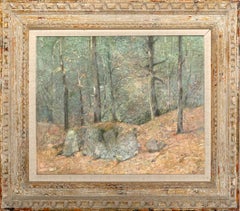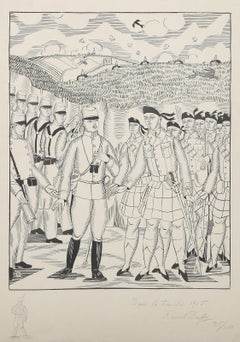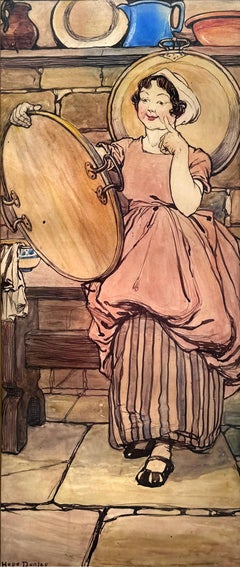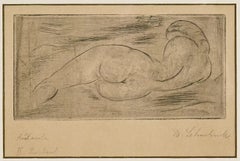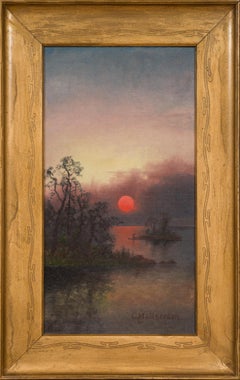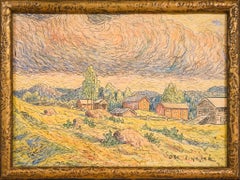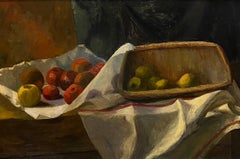1910s Art
to
766
1,116
403
382
167
164
Overall Width
to
Overall Height
to
7,525
20,742
155,879
236,898
1,876
2,284
4,820
6,372
5,904
13,145
20,122
24,829
17,376
13,279
5,321
428
310
137
137
45
19
17
6
5
1
1,280
855
31
1,483
745
597
430
410
391
223
146
143
139
135
134
130
103
98
85
83
82
65
60
817
583
462
443
365
101
47
34
24
22
789
361
1,252
903
Period: 1910s
Hallström’s Masterful Vision of a Northern Evening
Located in Stockholm, SE
Sunset Over Northern Waters is an oil on canvas painting by Swedish artist Carl Hallström (1850–1929). It depicts a serene Nordic sunset in which a glowing red sun hovers low over st...
Category
Romantic 1910s Art
Materials
Canvas, Oil
A Northern Vision in Miniature
Located in Stockholm, SE
This exquisitely detailed drawing by Swedish artist Oscar Lycke captures a rustic settlement nestled in the golden highlands of northern Sweden, most likely depicting the traditional...
Category
Impressionist 1910s Art
Materials
Paper, Crayon, Watercolor, Pencil
Cattle in Farm Landscape - American Impressionist art landscape oil painting
Located in London, GB
This stunning Impressionist farm landscape oil painting is by one of the leading American Impressionist artists, William Samuel Horton. Horton moved to England in1918 and travelled e...
Category
American Impressionist 1910s Art
Materials
Oil
Impressionist English landscape with cows, trees during the Summertime
By George Léon Little
Located in Woodbury, CT
George Leon Little (1862–1941)
English Impressionist Landscape with Cattle
Oil on canvas, circa 1910
Presented in an ornate gilt composition frame
This tranquil pastoral scene, pai...
Category
Impressionist 1910s Art
Materials
Canvas, Oil
Northern Valley View – Light, Stillness and Depth in the Swedish North
Located in Stockholm, SE
In this luminous landscape, Oscar Lycke invites us to experience the serene vastness of Sweden’s northern interior. Likely painted in the region surrounding Liden along the Indalsälv...
Category
Impressionist 1910s Art
Materials
Canvas, Oil, Board
Apples and Lemons by Edith LUTZ - Oil on Canvas - 64x96 cm
Located in Geneva, CH
Edith Lutz-Romani (1894-1983) was an Austrian painter active during the 20th century. Although detailed information about her life is limited, she was born in 1894 and developed her ...
Category
Academic 1910s Art
Materials
Canvas, Oil
Bathers, Oil on Canvas, 1914
Located in Saint Amans des cots, FR
Oil on canvas by Roger GRILLON (1881-1938), France, 1914. "Bathers". With frame: 114x94 cm - 44.9x37 inches ; without frame: 92x73cm - 36.2x28.75 inches. 30F format. Signed lower lef...
Category
Impressionist 1910s Art
Materials
Canvas, Oil
View Over Häggvik, Nordingrå. A UNESCO World Heritage-listed Area
Located in Stockholm, SE
Carl Johansson (1863–1944) was a Swedish painter renowned for his evocative landscapes, particularly those capturing the striking natural beauty of northern Sweden. His works reflect...
Category
1910s Art
Materials
Oil, Wood Panel
$3,171 Sale Price
20% Off
(Monument to Cezanne) original lithograph
Located in Henderson, NV
Medium: original lithograph. Catalogue reference: Guerin 265. This lithograph was executed by Aristide Maillol in homage to Paul Cezanne. Printed in 1914 and published in Paris by Be...
Category
1910s Art
Materials
Lithograph
Sunlit Forest and Distant Blue Mountains – A Northern Swedish Landscape by Lycke
Located in Stockholm, SE
This luminous landscape painting by Oscar Lycke captures the rolling hills and deep forests of northern Sweden, likely from the Sundsvall region. The foreground is dominated by lush ...
Category
Post-Impressionist 1910s Art
Materials
Oil, Board
Man on His Back, Nude
Located in Fairlawn, OH
Man on His Back, Nude
Lithograph, c. 1916
Signed by the artist lower right: Geo Bellows (see photo)
Annotated bottom left: No. 3 by the artist (see photo)
An unredorded trial proof b...
Category
Ashcan School 1910s Art
Materials
Lithograph
French Village Landscape Scene w/ Trees & Buggy, Early 20th Century
Located in Beachwood, OH
Auguste-Louis Lepère (French, 1849-1918)
Untitled Landscape, c. 1910
Watercolor
Signed lower right
14 x 16.5 inches
20 x 22.5 inches, framed
Auguste-Louis Lepère was a French painte...
Category
1910s Art
Materials
Watercolor
Antique French Impressionist Oil Riverbank Hay Barge in Paris Pont Saint-Marie
Located in Cirencester, Gloucestershire
The Hay Barge, Paris
Pont Saint-Marie
French Impressionist artist, c. 1918
signed with monogram verso, dated 1918
oil on board, unframed
board : 8.25 x 10.25 inches
Provenance: priva...
Category
Impressionist 1910s Art
Materials
Oil
Head of a Gaul, British Museum Roman Classical sculpture photogravure
Located in Melbourne, Victoria
'Head of a Gaul'
Photogravure from a collection of photogravures depicting Greek and Roman marbles and bronzes in the British museum. Plate number above top right corner of the imag...
Category
Other Art Style 1910s Art
Materials
Photogravure
“Skogskanten” (Winter Landscape with Spruce Trees)
Located in Stockholm, SE
Oskar Bergman (Stockholm 1879–1963 Saltsjöbaden)
“Skogskanten” (Winter Landscape with Spruce Trees)
signed "Oskar Bergman" in pencil
drypoint etching
image size: 19.5 x 29.5 cm (7 ...
Category
Naturalistic 1910s Art
Materials
Paper, Drypoint, Etching
After the Storm
Located in Stockholm, SE
"After the Storm" is the title of this oil painting on canvas by the Swedish artist Hjalmar Berghcrantz (1889–1961). Signed and dated 1917. The artwork depicts a rugged landscape whe...
Category
Naturalistic 1910s Art
Materials
Canvas, Oil
$1,393 Sale Price
20% Off
Two Worlds - British Edwardian figurative interior oil painting religious art
Located in London, GB
This intriguing British Edwardian figurative interior oil painting is by noted artist Arthur Croft Mitchell. It is entitled Two Worlds verso and dated as c1910. The composition of th...
Category
Realist 1910s Art
Materials
Oil
Winter Sunset - The Lys - Neo-Impressionist Landscape Oil by Jenny Montigny
Located in Marlow, Buckinghamshire
Signed oil on artist's board riverscape circa 1910 by Belgian neo-impressionist painter Jenny Montigny. The piece depicts a view of the River Lys in winter as the sun sets. The river...
Category
Post-Impressionist 1910s Art
Materials
Oil, Board
The Bridge Over the Sauceron at Nesles la Vallée (Val d'Oise) Maurice de Lambert
Located in SANTA FE, NM
"The Bridge upon the Sauceron at Nesles la Vallée (Val d'Oise), 1918"
Maurice Walter Edmond de Lambert (French, 1873-1952)
Oil on cardboard
Signed and dated lower right
10 3/4 x 8 3/...
Category
Post-Impressionist 1910s Art
Materials
Cardboard, Oil
Antique American Marine Seascape Oil Painting Crashing Surf Atlantic Coast Maine
Located in Portland, OR
A fine antique seascape oil painting on panel by the celebrated marine artist, Frederick Judd Waugh (1861-1940), depicting the Atlantic of the coast of Maine, circa 1910.
The painting is finely executed with bold and decisive brush strokes with crisp edges, one can almost hear the roar of the ocean as the surf crashes upon the rocks. The painting is signed lower right "Waugh" and is housed in the original carved & gilded frame.
Condition is very good indeed, this fine seascape by one of America's most acclaimed late 19th early 20th century marine artists is ready to grace your wall. The painting will be accompanied with a certicificate of authenticity & provenance.
Frederick Judd Waugh was an American artist, primarily known as a marine artist. During World War I, he designed ship camouflage for the U.S. Navy, under the direction of Everett L. Warner.
Waugh was the son of a well-known Philadelphia portrait painter, Samuel Waugh. He studied at the Pennsylvania Academy of Fine Arts with Thomas Eakins, and at the Académie Julian in Paris with Adolphe-William Bouguereau. After leaving Paris, he moved to England, residing on the island of Sark in the English Channel, where he made his living as a seascape painter. In 1898 he was recorded as living in Heath and Reach, Bedfordshire.
In 1908, Waugh returned to the U.S., settling in Montclair Heights, New Jersey. He had no studio until art collector William T. Evans (a railroad financier and President of the dry goods firm, Mills Gibbs Corporation) offered him one in exchange for one painting a year. In later years, he lived on Bailey Island, Maine, and in Provincetown, Massachusetts.
Waugh’s marinescapes were highly acclaimed, garnering him the Popular Prize at the Carnegie International Exhibition for five years in a row, a feat accomplished by no other artist. In 1914, he was a judge of the art exhibit on Monhegan Island, Maine during the 1914 Ter-Centenary celebration of the Voyage of Captain John Smith.
In addition to his marinescapes, Waugh sometimes published work in periodicals, such as The Green Sheaf, to which he contributed at least one illustration. He also produced paintings and sketches on legendary and mythological themes; see, for instance, his 1921 sketch “Levitation in Dream No. 3”, and his c. 1912 painting “The Knight of the Holy Grail”.
In 1918, Waugh was recommended to serve as a camouflage artist (or camoufleur) for the U.S. Navy, as a member of the Design Section of its marine camouflage unit. That section was located in Washington, D.C., and was headed by American painter Everett L. Warner.
According to a biography of Waugh, “Many large ships, including the Leviathan, were painted according to his designs. Though the enterprise was of course a team effort in which no man played a solo part, he had every reason to be proud of his record. Only one ship with his system of camouflage was lost during the war”.
Waugh was known to produce literary work, publishing a short poem in Pamela Colman Smith’s short-lived periodical The Green Sheaf; a fairy tale in The English Illustrated Magazine; and, in 1916, the book The Clan of Munes...
Category
Realist 1910s Art
Materials
Panel, Oil
Monochromatic Delicate Impressionist Landscape " A Forest Scene"
By Emil Carlsen
Located in Miami, FL
Danish-American artist Søren Emil Carlsen paints a post-impressionist landscape that blurs the line between representation and abstraction. With its open composition, the artist capt...
Category
Post-Impressionist 1910s Art
Materials
Canvas, Oil
Tropical Blue Water Lush Beach Scene Nicely Framed Seascape Summer Oil Painting
Located in Buffalo, NY
Antique American impressionist beach scene oil painting. Oil on canvas. Signed. Framed. Measuring 27 by 31 inches overall and 20 by 24 painting alone. In excellent original condition...
Category
Impressionist 1910s Art
Materials
Oil, Canvas
$1,820 Sale Price
20% Off
Standing Nude
By Eugene Wagner
Located in Los Angeles, CA
An original carved wood sculpture of an Art Deco standing nude .
German sculptor (1871 Berlin to 1942 ibid), studied at the Dresden Academy, took part in exhibitions in Munich, Düsse...
Category
Art Deco 1910s Art
Materials
Wood
Moonlight over the Lake, 1912, By Swedish Artist Wilhelm Dahlbom
Located in Stockholm, SE
We are pleased to present this exquisite piece by Swedish artist Wilhelm Dahlbom, entitled "Moonlight, Idö, 1912". This work captures the serene reflection of moonlight on water, the...
Category
Romantic 1910s Art
Materials
Canvas, Oil
Standing Female Nude
Located in Fairlawn, OH
Standing Female Nude
Drypoint, c. 1910
Unsigned
Estate authentication on verso (see photo)
Estate authentication verso by Frances Frieseke Kilmer (Mrs. Kenton Kilmer, 1914-1998) (see...
Category
American Impressionist 1910s Art
Materials
Drypoint
Wind Blown Poplars
Located in Santa Monica, CA
WILLIAM SELTZER RICE (1873 – 1963)
WIND BLOWN POPLARS c. 1915-20
Color woodcut, Signed and titled in pencil. 9 x 12”. On thin paper....
Category
American Impressionist 1910s Art
Materials
Woodcut
$3,600 Sale Price
20% Off
Antique American Impressionist Sun Dappled River Landscape Framed Oil Painting
Located in Buffalo, NY
Very nicely painted and impressive early 1900s American school landscape painting. Oil on canvas. Framed. Excellent ready to hang condition.
Category
Impressionist 1910s Art
Materials
Canvas, Oil
$1,980 Sale Price
20% Off
Four Hooded Crows in a Winter Landscape, c. 1910–1915
Located in Stockholm, SE
This quietly atmospheric painting by Jon Loman captures a group of four hooded crows in a snow-covered winter landscape. Three of the birds perch on a rustic wooden fence, while the ...
Category
Impressionist 1910s Art
Materials
Canvas, Oil
Original poster by Aleksandr Deineka - Soviet Propaganda - Children
Located in PARIS, FR
The circa 1920 poster by Aleksandr Deineka exemplifies his distinctive approach to Soviet visual art during the early years of the Soviet Union. Known for his versatility and ability...
Category
1910s Art
Materials
Paper, Linen, Lithograph
Aprilafton, Delsbo (April Evening, Delsbo), c. 1910
Located in Stockholm, SE
Oscar Lycke’s Aprilafton, Delsbo (“April Evening, Delsbo”), c. 1910, is a luminous oil painting that masterfully captures the gentle transition from winter to early spring in the rur...
Category
Post-Impressionist 1910s Art
Materials
Canvas, Oil
Moonlit Tranquility: Hugo Carlberg’s Atmospheric Nocturne, c. 1910–1913
Located in Stockholm, SE
A rare and poetic nocturne by Swedish artist Hugo Carlberg, Moonlight evokes the hushed stillness of a moonlit landscape. Silvery reflections shimmer across the water as tall trees c...
Category
Post-Impressionist 1910s Art
Materials
Oil, Board
$4,709 Sale Price
20% Off
'Woolworth Building Under Construction' — Early 20th Century Modernism
By Earl Horter
Located in Myrtle Beach, SC
Earl Horter, 'The Woolworth Building Under Construction', etching, c. 1912, edition not stated. Signed in pencil. A fine, richly-inked impression, in warm black ink, with selectively...
Category
American Modern 1910s Art
Materials
Etching
20th century English River landscape of Bisham Abbey on the Thames, Fisherman
Located in Woodbury, CT
Alfred Augustus Glendening Senior (English, 1840–1921)
View along the Thames at Bisham Abbey, oil on canvas, circa 1910
Signed Bottom right
This beautifully observed riverscape by A...
Category
Victorian 1910s Art
Materials
Canvas, Oil
The Yellow Hat - American School
Located in North Clarendon, VT
Fun early 20th century American Impressionist painting of a woman in a fancy hat. Heavy impostor, oil on artist board. Faint writing on verso - might be a signature. 16" x 12" housed...
Category
American Impressionist 1910s Art
Materials
Oil
'Sunny Afternoon', Chicago Impressionist, Paris, Grande Chaumiére, Woman Artist
Located in Santa Cruz, CA
Signed lower left, 'Pauline Palmer' (American, 1867-1938) and painted circa 1915, two years after the artist's first solo exhibition at the Art Institute of Chicago.
Exhibited: Chicago Galleries Association and titled, 'Sunny Yards' (attached, partial label from original frame)
A staunch proponent of pure Impressionism at the turn of the twentieth century, Pauline Palmer influenced the world of American art far beyond her Midwestern art community. Primarily known for her landscapes and portraits, Palmer rejected the waves of modernism that hit the United States in the teens and twenties, remaining true to the traditions of Impressionism. In 1923, she established the Association of Chicago Painters and Sculptors as an alternative to the increasing number of institutions celebrating Abstraction and Cubism.
Pauline Palmer was enrolled at the Art Institute of Chicago from 1893 to 1898, and studied with some of the most prominent artists of the period, including William Merritt Chase and Frank Duveneck.
Following her graduation, Palmer moved to Paris and attended the Académie de la Grande Chaumiére and the Académie Colarossi, where she studied under Raphael Collin. While in France, she exhibited with success including at the Paris Salon each year from 1903-06 and, again, in 1911. Her principal teacher and friend in Paris was the American Impressionist, Richard Emil Miller, whose shimmering handling of light made a profound impression upon her. Palmer also traveled extensively throughout Europe, a rite of passage for aspiring artists of her time. Returning to Paris, she studied with Gustave Courtois and Lucien Simon, both exemplars of compositional structure. Upon her return to the United States, Palmer set up her first American studio in the legendary Tree Studios building in Chicago.
The artist's husband, Dr. Albert Palmer, whom she had married in 1891, both supported and encouraged his wife's artistic development. The couple kept a summer home in Provincetown, Massachusetts, where she made friends with many of the Portuguese fishermen's families, often using their children and the routines of their daily lives as subject matter for her painting.
Pauline Palmer exhibited widely and with success, including in Italy, France, Norway and throughout the United States. Her works were shown at the National Association of Women Painters and Sculptors and, beginning in 1899, she exhibited at the Art Institute of Chicago for twenty-seven consecutive years. Over the course of her long career, she exhibited over 250 paintings at the Art Institute of Chicago, including at two solo exhibitions. She was the recipient of numerous prizes, medals and juried awards including nearly all the AIC's major awards, purchase prizes and honorable mention citations. Palmer also received a gold medal from the Colarossi Academy in Paris. Involved in numerous artist organizations, she was a member of the Chicago Municipal Art League, the Chicago Art Guild, the Chicago Arts Club and a charter member of the Chicago Women's Salon. Elected the first woman president of the Chicago Society of Artists, she went on to serve as president of both the Art Institute Alumni Association and the Chicago Association of Painters and Sculptors.
Considered by the Modernists of her day to be a traditionalist, Pauline Palmer remained true to her artistic vision and she continues to be regarded as one of the leading women of American Impressionism. Her light-filled, colorful compositions captured landscapes and scenes of American daily life with unusual freshness and seeming effortlessness. Celebrated during her life as "Chicago's Painter Lady," Palmer was honored twelve years after her death by a posthumous retrospective at the Art Institute of Chicago and the establishment of an annual scholarship awarded in her honor by the Art Institute of Chicago.
(with thanks to Hali Thurber)
CHRONOLOGY
1867, Born in McHenry, IL
1885, Moves to Chicago to teach art
1891, Marries Dr. Albert Elwood Palmer
1893, Exhibits, World's Columbian Exposition, Chicago
1896, First exhibits at the Art institute of Chicago
1898, Exhibits at Exposition in Omaha, NE
1899, First exhibit, Pennsylvania Academy of Fine Arts
1900-1902, Studies with various artists in Paris
1901, Exhibits at Exposition in Buffalo
1903-1906, Exhibits at Paris Salon
1904, Exhibits at Universal Exposition in St. Louis,
1907, Four prizes at the Art Institute of Chicago
1911, Exhibits at the Paris Salon
1911, Exhibits at the Expositione de Belle Arti, Naples
1913, Solo exhibition, Art Institute of Chicago
1915, First prize, Society of Western Artists
1917, Opens first American studio in Chicago
1918, First woman president, Chicago Society of Artists 1918-1929, holds position of president for 11 years
1918-1921, Silver medals, Society of Chicago Artists
1921, Silver medal at Peoria Society of Allied Artists
1927, President, The Art Institute Alumni Association
1929-1931, President, Chicago Association of Painters and Sculptors
1938, Dies, Trondheim, Norway
AWARDS
1904, Universal Exposition in St. Louis, bronze medal
1907, Art Institute 's Chicago Artists' Exhibition
1915, Society of Western Artists exhibition, first prize
1918, Society of Chicago Artists, silver medal
1921, Peoria Society of Allied, silver medal
Solo Exhibitions:
1913, Art Institute of Chicago
1939, Art Institute of Chicago, memorial exhibition
Union League Club of Chicago, memorial exhibition
Group Exhibitions:
1893, World's Columbian Exposition in Chicago
1896, Art institute of Chicago
1898, Exposition in Omaha, NE
1899, Pennsylvania Academy of Fine Arts
1899-1926, Art Institute of Chicago
1901, Exposition in Buffalo
1903-06 Paris Salon
1904, Universal Exposition in St. Louis
1911, Paris Salon
1911, Expositione de Belle Arti, Naples
1915, Exposition in San Francisco
1950, Chicago Galleries Association
1984, Lakeview Museum of Arts and Sciences, Peoria
Memberships:
1918-29, First woman President,Chicago Society of Artists
1927, President of The Art Institute Alumni Association
1929-31, President of Chicago Association of Painters and Sculptors
Reference:
E. Benezit, Dictionnaire des Peintres, Sculpteurs, Dessinateurs, et Graveurs, Jacques Busse, 1999 Nouvelle Édition, Gründ 1911, Vol. X, page 523; Thieme-Becker Allgemeines Lexikon der Bildenden Künstler von der Antike bis zu Gengenwart, Ulrich Thieme and Felix Becker, Deutscher Taschenbuch Verlag 1992, Vol. XXVI, page 129; Who Was Who in American Art 1564-1975: 400 Years of Artists in America, Peter Hastings Falk, Sound View Press 1999, Vol. III, page 2512; Mantle Fielding’s Dictionary of American Painters, Sculptors and Engravers, Glen B. Opitz, Apollo Press 1983, page 708; Biographical Encyclopedia of American Painters, Sculptors & Engravers of the U.S.: Colonial to 2002, Bob Creps, Dealer’s Choice Books, Inc. 2002, Vol. II, page 1047; Mallett’s Index of Artists, Daniel Trowbridge Mallett, Peter Smith: New York 1948 Edition, R.R. Bowker Company 1935, page 326; Pauline Lennards Palmer...
Category
American Impressionist 1910s Art
Materials
Oil, Illustration Board
La Danse Macabre
Located in West Hollywood, CA
Belgian Symbolist artist Jan Frans DeBoever (1872 - 1948), created symbolist/allegorical paintings throughout his lifetime. He centralized on allegorical and literary subjects, generally depicting the constant struggle of good vs. evil. This is consistently reflected by images of beautiful women interacting with skeletons, gargoyles and demons.
La Danse Macabre...
Category
Symbolist 1910s Art
Materials
Mixed Media
1001 Nights - SURREALIST WOMAN DEAD IN A TREASURE BOX
Located in Santa Monica, CA
RICHARD TESCHNER (Prague 1879 – 1948)
From: A Thousand and One Nights -
SURREALIST WOMAN DEAD IN A TREASURE BOX, 1917 Aquatint, Proof no. 17. Aqua...
Category
Symbolist 1910s Art
Materials
Aquatint
Antique Scottish Oil Painting Highland Path with Cattle Atmospheric Landscape
Located in Cirencester, Gloucestershire
Highland Path with Cattle
by Henry Hadfield Cubley (British 1858-1934)
signed, dated verso 1915
oil on canvas, framed
Framed: 32 x 21.5 inches
Canvas : 30 x 20 inches
Inscribed verso...
Category
Victorian 1910s Art
Materials
Oil, Canvas
Saint Roch with Saint Jerome + Saint Sebastian - British Edwardian oil painting
Located in London, GB
This superb religious figurative oil painting is by noted artist Wilfred de Glehn. Although some experts rank de Glehn alongside Sargent, he is considered as something of a late British Renoir, for his deft use of sunlight and shadow. Indeed he was good friends with John Singer Sargent and collaborated with his on some projects. This painting, painted circa 1910 is of three saints, from left to right they are Saint Jerome, Saint Roch and Saint Sebastian. It is based on a work attributed to 16th century artist Alessandro Oliverio. Saint Jerome was a biblical translator and monastic leader and is depicted in red, holding books. Saint Roch and Saint Sebastian were known as the Plague saints - Plague saints offered hope and healing before, during, and after times of plague. A specific style of painting, the plague votive, was considered a talisman for warding off the plague. It portrayed a particular saint as an intercessor between God and the person or persons who commissioned the painting – usually a town, government, lay confraternity, or religious order to atone for the "collective guilt" of the community. Rather than a society depressed and resigned to repeated epidemics, these votives represent people taking positive steps to regain control over their environment. Paintings of Roch represent the confidence in which renaissance worshipers sought to access supernatural aid in overcoming the ravages of the plague. The thirteenth-century Saint Roch (or Rocco), whose death is still commemorated in Italy, is especially invoked against the plague. He attended plague victims in public hospitals in Italy according to traditional accounts of his life. Images attributed to the Spanish historical painter Nicolás Borrás in the Royal Cornwall Museum, or other works in institutions from The National Gallery to the Wallace Collection, show him baring his thigh to show the mark of the plague, as he is in this painting. Saint Roch is also the patron saint of dogs, after one carried food to him in the prison where he died...
Category
Old Masters 1910s Art
Materials
Oil
The Rivers Edge
Located in North Clarendon, VT
The River's Edge a beautiful American Impressionist oil on canvas attributed to William Baxter Closson. Housed in a period Foster Brothers frame.
Born October 13, 1848, in Thetford,...
Category
American Impressionist 1910s Art
Materials
Oil
$1,200
Antique American Impressionist Winter River Snow Covered Landscape Oil Painting
Located in Buffalo, NY
Antique American impressionist landscape oil painting. Oil on board. Framed. Signed. In excellent original condition. Handsomely framed in a giltwood molding. Excellent conditio...
Category
Impressionist 1910s Art
Materials
Oil, Board
Portrait of Alan Sims with Bird Nest - British Edwardian art oil painting
Located in London, GB
This lovely British Edwardian Impressionist portrait oil painting is by noted artist Charles Henry Sims. Painted circa 1910, the young child in the painting is Alan Sims, the artist'...
Category
Impressionist 1910s Art
Materials
Oil
ZANG TUMB TUMB - Rare Book - 1914
Located in Roma, IT
One of the main and most famous works by the Italian futurist poet F.T. Marinetti ( Alessandria d'Egitto , 1876 – Bellagio , 1944 ), clearly inspired by the Adrianople siege in 1912, which he witnessed as a reporter for L'Intransigeant . It is considered one of the most typical futurist work, since the author conceived it using different fonts, dimensions and other graphic elements that were responsible to take the reader right inside the battle. In fact, “the dynamic rhythms and onomatopoetic possibilities that the new form of expression offered, was made even more effective through the revolutionary use of different typefaces, forms and graphic arrangements and sizes that became a distinctive part of Futurism. ” (Caroline Tisdall-Angelo Bozzola...
Category
Surrealist 1910s Art
Materials
Paper
$1,081 Sale Price
25% Off
'Parisian Model', Paris, Royal Academy, André Lhote, Fin de Siècle, Carmen
Located in Santa Cruz, CA
A strong, character-driven study of the artist's model, "Carmen", painted during the first year of the artist's second Paris period, when he resolutely abandoned his earlier Beaux-Ar...
Category
Modern 1910s Art
Materials
Canvas, Oil
Klimt, Sonnenblume, Das Werk von Gustav Klimt (after)
By Gustav Klimt
Located in Auburn Hills, MI
Héliogravure, collotype vélin paper. Paper Size: 18.23 x 17.32 inches; image size: 11.77 x 11.61 inches. Inscription: Signed in the plate and unnumbered, as issued. Notes: From the f...
Category
Symbolist 1910s Art
Materials
Lithograph
$27,996 Sale Price
20% Off
Original For Every Fighter A Woman Worker, Y.W.C.A. vintage poster WW1
Located in Spokane, WA
For Every Fighter a Woman Worker. Original vintage poster. Linen Lined. Very good condition. Artist: Ernest Hamlin Baker. Size: 28" x 42". Year: 1918 Linen backed trimme...
Category
American Modern 1910s Art
Materials
Lithograph
$1,000 Sale Price
20% Off
At the Claremont (View of the Hudson River and Palisades), Ida Sedgwick Proper
Located in New York, NY
Ida Sedgwick Proper
At the Claremont (View of the Hudson River and Palisades)
circa 1912
Signed lower right
Oil on canvas
45 1/4 x 57 1/2 inches
Exhibited
New York, Heterodoxy, Malv...
Category
American Impressionist 1910s Art
Materials
Oil, Canvas
Sunset Over the Lake, 1919 by Swedish Artist Carl Kjellin (1862-1939)
Located in Stockholm, SE
"Sunset Over the Lake" by Carl Kjellin is a Nordic Light painting capturing the ephemeral beauty of a lake at sunset. The vibrant canvas, dominated by a b...
Category
Post-Impressionist 1910s Art
Materials
Canvas, Oil
$4,613 Sale Price
20% Off
Antique American Impressionist Seal Rocks California Coastal Seascape Painting
Located in Buffalo, NY
Nicely painted early American impressionist seacape painting by Elmer Ellsworth Garnsey (1862 - 1946). Oil on board. Framed. Signed verso. Image s...
Category
Impressionist 1910s Art
Materials
Canvas, Oil
Les Vacances - Post Impressionist Figures in Landscape Oil by Pierre Montezin
Located in Marlow, Buckinghamshire
Signed oil on canvas figures in riverscape circa 1910 by sought after French impressionist painter Pierre Eugene Montezin. The work depicts women dressed in summer dresses and sunhat...
Category
Impressionist 1910s Art
Materials
Canvas, Oil
Klimt, Der Kuss, Das Werk von Gustav Klimt (after)
By Gustav Klimt
Located in Auburn Hills, MI
Héliogravure, collotype vélin paper. Paper Size: 18.23 x 17.32 inches; image size: 11.89 x 11.85 inches. Inscription: Signed in the plate and unnumbered, as issued. Notes: From the f...
Category
Symbolist 1910s Art
Materials
Lithograph
$31,996 Sale Price
20% Off
Early 20th Century Seascape of Capri, Amalfi Coast
Located in Soquel, CA
Luminous early 20th Century seascape of Capri on Amalfi Coast by Albert Wenk (German, 1863-1934), 1913. Signed and dated lower left corner. Cond...
Category
Post-Impressionist 1910s Art
Materials
Linen, Oil, Stretcher Bars
'Bacchanal', Paris Salon Modernist Oil, Royal Academy, Charlottenborg, Benezit
Located in Santa Cruz, CA
Signed lower right, 'Ludvig Jacobsen' (Danish, 1890-1957) and dated 1926.
An exceptional early twentieth-century figural work by this notable Danish modernist and follower of Wattea...
Category
Post-Impressionist 1910s Art
Materials
Canvas, Oil
French school Windmill scene Oil painting Signed
Located in Zofingen, AG
➡️Windmills scene from Grandin⬅️
Probably Louis Grandin born à Chevresis - Monceau ( Aisne ) France. Mentioned in the book "Society of French Artist " in le Salon 1936
This painti...
Category
Impressionist 1910s Art
Materials
Gesso, Oil, Wood Panel, Stretcher Bars
$288 Sale Price
82% Off
19th C. American Impressionist Gouache of Colorado Mountains in Spring
Located in Denver, CO
This original circa 1910s plein air field study by renowned Colorado landscape artist Charles Partridge Adams captures the serene beauty of the Rocky Mountains in a masterful display...
Category
American Impressionist 1910s Art
Materials
Gouache
Picasso, Composition (Hodorisch B2), Le manuscrit trouvé dans un chapeau (after)
Located in Auburn Hills, MI
Lithograph on vélin des papeteries Lafúma paper. Unsigned and unnumbered, as issued. Good condition. Notes: From the album, Le manuscrit trouvé dans un chapeau, orné de dessins a la ...
Category
Modern 1910s Art
Materials
Lithograph
$716 Sale Price
20% Off
Antique American Impressionist Flower Garden Landscape Framed Oil Painting
Located in Buffalo, NY
Antique American impressionist flower garden landscape oil painting. Oil on canvas. Framed. No signature found.
Category
Impressionist 1910s Art
Materials
Canvas, Oil
$1,400 Sale Price
20% Off
Original "For Your Boy, YMCA, vintage WW1 1918 poster
Located in Spokane, WA
Original. YMCA for Your Boy. Acid-free original vintage poster in excellent condition with archival linen backing, ready to frame. Certificate o...
Category
American Realist 1910s Art
Materials
Lithograph
$620 Sale Price
20% Off
“India, 1912”
Located in Southampton, NY
Original watercolor and gouache on paper of a busy street scene in India done in 1912 by the American artist, William Henry Drake. Copyrighted signed and dated 1912 lower left. Condition is good. Recently professionally matted. Unframed. Overall matte size is 12 by 16 inches. Provenance: A Long Island, New York estate.
William Henry Drake
Born: 1856 New York
Died: 1926 Los Angeles
Nationality: American
Education: Académie Julian, Art Students League of New York
Known for: Painting, illustration
Awards: National Academy
Biography:
Drake studied at the Académie Julian in Paris, with Jean-Joseph Benjamin-Constant and Henri Lucien Doucet.
Back from Europe, he studied at the Cincinnati School of Design, and would often go to the zoo, where he could draw the animals. He was then employed by the Museum of Natural History. He continued to study at the Art Students League of New York. In 1878 he worked as a freelance pen-and-ink artist for such periodicals as Century or Harper’s with animal studies...
Category
Academic 1910s Art
Materials
Paper, Watercolor, Gouache
$695 Sale Price
24% Off
Paul Klee, Garten Der Leidenschaft (Garden of Passion)
By Paul Klee
Located in New York, NY
Kornfeld 56. 50 published with the book Expressionismus Die Kunstwende, 1918, in addition to 54 earlier impressions. Signed and titled in pencil in bottom margin under image.
Category
Modern 1910s Art
Materials
Etching
Recently Viewed
View AllMore Ways To Browse
18th Century Dutch Oil Paintings
19th Century Oil Painting Pastoral Scene
1965 Watch
Wrestler Sculpture
15th Century Italian Painting
Wrestling Vintage
1962 Watch
18th Century Oil Painting Woman
1965 Vintage Watch
1984 Clothing
19th Century Painting Lovers
Woman Posing Seated
1974 Vintage Watch
1930s Actress
1953 Watch
Wood Carving Portrait
18th Century Venetian Paintings
1980 Japanese Poster
